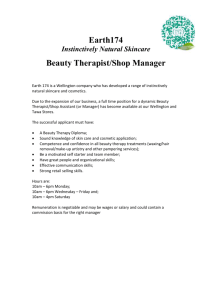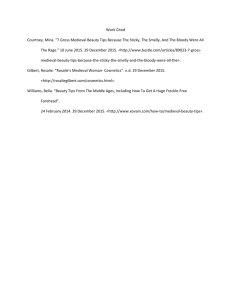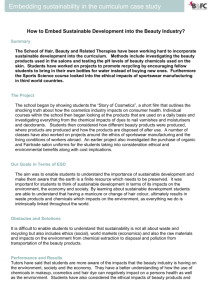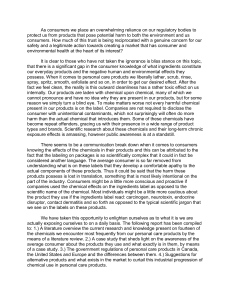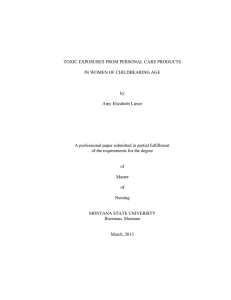Skin Deep - Dangerous Cosmetics or Natural
advertisement
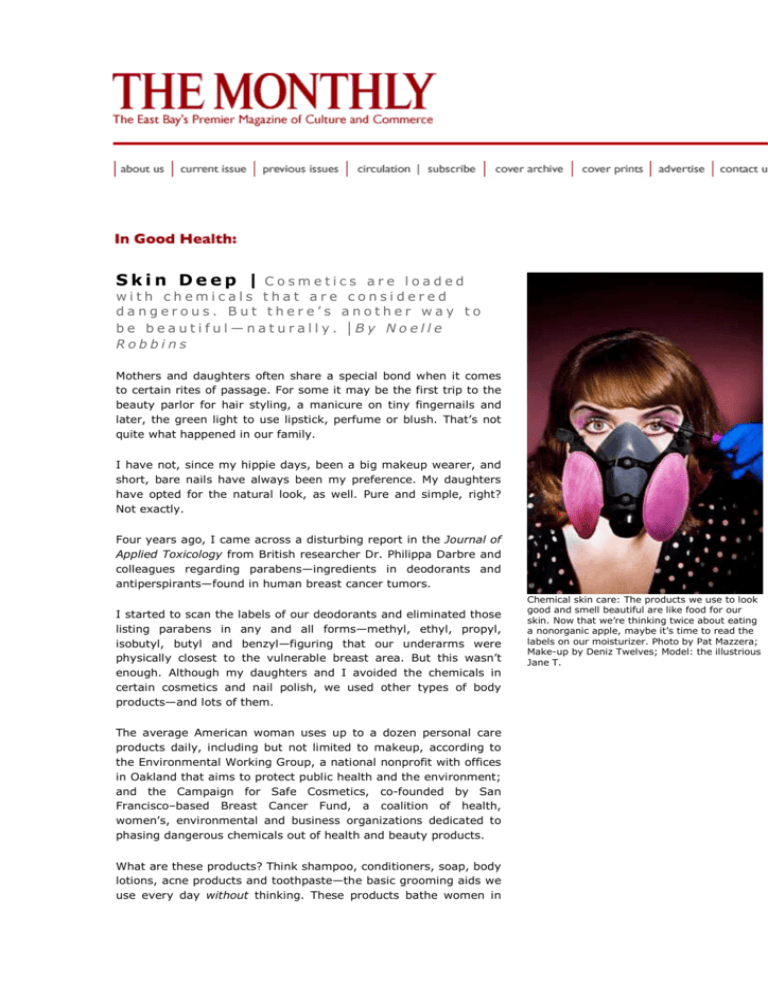
Skin Deep | Cosmetics are loaded with chemicals that are considered dangerous. But there’s another way to be beautiful—naturally. | By Noelle Robbins Mothers and daughters often share a special bond when it comes to certain rites of passage. For some it may be the first trip to the beauty parlor for hair styling, a manicure on tiny fingernails and later, the green light to use lipstick, perfume or blush. That’s not quite what happened in our family. I have not, since my hippie days, been a big makeup wearer, and short, bare nails have always been my preference. My daughters have opted for the natural look, as well. Pure and simple, right? Not exactly. Four years ago, I came across a disturbing report in the Journal of Applied Toxicology from British researcher Dr. Philippa Darbre and colleagues regarding parabens—ingredients in deodorants and antiperspirants—found in human breast cancer tumors. I started to scan the labels of our deodorants and eliminated those listing parabens in any and all forms—methyl, ethyl, propyl, isobutyl, butyl and benzyl—figuring that our underarms were physically closest to the vulnerable breast area. But this wasn’t enough. Although my daughters and I avoided the chemicals in certain cosmetics and nail polish, we used other types of body products—and lots of them. The average American woman uses up to a dozen personal care products daily, including but not limited to makeup, according to the Environmental Working Group, a national nonprofit with offices in Oakland that aims to protect public health and the environment; and the Campaign for Safe Cosmetics, co-founded by San Francisco–based Breast Cancer Fund, a coalition of health, women’s, environmental and business organizations dedicated to phasing dangerous chemicals out of health and beauty products. What are these products? Think shampoo, conditioners, soap, body lotions, acne products and toothpaste—the basic grooming aids we use every day without thinking. These products bathe women in Chemical skin care: The products we use to look good and smell beautiful are like food for our skin. Now that we’re thinking twice about eating a nonorganic apple, maybe it’s time to read the labels on our moisturizer. Photo by Pat Mazzera; Make-up by Deniz Twelves; Model: the illustrious Jane T. close to 170 chemical ingredients. And women are not alone in this shower of daily chemicals. The survey also showed that men use an average of six products a day containing 85 chemicals. And these ingredients don’t just sit on our skin; they soak in and are absorbed in our bloodstream. We also inhale them and ingest them. What chemicals are in our bodies now? And what is being done to protect us from future harm? The Centers for Disease Control (CDC) in 2000 began a project using a scientific tool called “biomonitoring” to measure the level of artificial chemicals present in the bodies of thousands of typical Americans. The CDC is measuring the so-called “body burden” or total amount of toxic chemicals, both natural and synthetic, present in the human body at a given point in time. Using blood, urine and breast- milk samples, it’s a snapshot of the level of chemicals to which a body has been exposed through inhalation, ingestion or absorption through the skin. The Environmental Working Group reported that “the blood and urine of the adult group contained 432 of 528 industrial compounds, pollutants and other chemicals tested, including chemicals linked to brain and nervous system toxicity, reproductive toxicity and fertility problems, and birth defects and developmental delays.” Some of these chemicals are present in products we not only assume are safe, but use to enhance our health and appearance. Stacy Malkan, Berkeley resident and co-founder of the Campaign for Safe Cosmetics, recently published a book responding to these concerns called Not Just a Pretty Face: The Ugly Side of the Beauty Industry. I sat down with Malkan, determined to get all the dirty facts on products designed to get us clean, keep our skin soft and wrinkle-free, clear our faces, and make us smell good in the bargain. Skin Skinny Cosmetics Watchdogs Baby Shampoo Study Raises Chemical Concerns—“Kids and Parenting,” Feb. 4, 2008, www.msnbc.msn.com Bay Area Working Group on the Precautionary Principle, www.takingprecaution.org Body Burden information, www.bodyburden.org, www.chemicalbodyburden.com Campaign for Safe Cosmetics, www.safecosmetics.org Environmental Working Group Skin Deep Report, (rates safety of ingredients in cosmetics and body products), www.cosmeticsdatabase.com Environmental Working Group, 1904 Franklin St., Suite 703, Oakland, (510) 444-0973; www.ewg.org Making Our Milk Safe (MOMS), www.safemilk.org —————————————— As a self-confessed cosmetics diva, Malkan knows what women (and men) face every day as they prepare to step out the front door. In her book she bluntly describes her own teenage styling passion: “We’re talking an elaborate morning ritual involving skin creams, eight kinds of makeup and multiple hair products, topped off by a generous cloud of Aqua Net Hair Spray . . . .” Twenty years later when she was able to dissect her youthful beauty routine, she discovered she was exposing herself to “200 chemicals in all, many of them toxic,” she says. Eliminating hundreds of potentially toxic chemicals can be overwhelming, so Malkan offered her main recommendations of cosmetic/body product ingredients we should attempt to remove from our beauty and grooming practices: parabens and phthalates. Parabens are used as preservatives in shampoos, deodorants, sunscreens, liquid hand soaps and body lotions, just to name a few Not Just a Pretty Face: The Ugly Side of the Beauty Industry, Stacy Malkan (New Society Publishers, 2007) Parabens and Phthalates, www.thinkbeforeyoupink.org Teens for Safe Cosmetics, Search for The Cause, www.teensforsafecosmetics.com The Ribbon, Newsletter of the Cornell University Program on Breast Cancer and Environmental Risk Factors, Report on British Studies Parabens in Human Breast Tissues (Winter 2004), www.nznaturalcosmetics.com/pcorn.pdf common products, and have been since the 1920s. Parabens extend shelf life, retard spoilage, and, of course, keep unpleasant things (like bacteria) from growing in our creamy potions. Which is all good, except that parabens also act like estrogen in our bodies. The Ribbon, newsletter of the Cornell University Program on Breast Cancer and Environmental Risk Factors, reported in 2004 that “recent evidence from over a dozen scientific studies indicates that several types of parabens can bind to the estrogen receptor and cause estrogen-like responses when tested in laboratory animals . . . .” There is a strong link between lifetime exposure to estrogen and the development of breast cancer in women. The Phthalate Information Center tells us that for 50-plus years phthalates have been used to fix fragrance in perfumes and to enhance nail-polish quality. The Information Center goes on to claim, “No governmental review has found any phthalate unsafe as used in products for the general public.” But there is increasing evidence that phthalate exposure may be linked to male reproductive problems in people and animals. Malkan described studies conducted by Shanna Swan, professor of obstetrics and gynecology and environmental medicine at University of Rochester. One focus of Swan’s work is to evaluate how being exposed to phthalates in the womb affects the reproductive development of male fetuses. And there is reason for concern: animal studies have demonstrated birth defects of the penis, undescended testicles and fertility issues due to the hormone-disrupting influence of phthalate exposure in the womb. The February issue of Pediatrics, the official journal of the American Academy of Pediatrics, reports a study showing elevated phthalate levels in babies after shampoos, baths and applying lotions and baby products. University of Rochester School of Medicine and Dentistry, Shanna Swan Ph.D., “Impact of Environmental Exposures on Male and Female Reproductive Health,” www.envmed.rochester.edu Organic and Natural: Who Says? Organic Trade Association, www.ota.com Natural Ingredient Resource Center, www.naturalingredient.org Industry and Government Reports Cosmetic Ingredient Review Expert (Industry) Panel, www.cir-safety.org FDA Partner, Information on Cosmetic Safety, www.cosmeticsinfo.org, www.ctfa.org, Personal Care Products Council Procter & Gamble’s Interpretation of U.S. and E.U. Cosmetic Regulation Similarities, www.pgbeautyscience.com U.S. and European Union Scientific Phthalate Findings, www.phthalates.org Natural Beauty Phthalates are in fragrances, too, and synthetic fragrances are in everything. Why else would we all smell so good? And while it is hard to say that these chemicals have unequivocally been proven dangerous to short- or long-term human health, why take chances? After all, it took years to learn that lead exposure leads to serious health consequences related to mental and behavioral development in children, and there are still lipstick brands that contain lead. Which brings us to the “precautionary principle.” The precautionary principle is an environmental guideline currently used in numerous international agreements (including the World Charter for Nature adopted by the United Nations General Assembly in 1982). Let’s see how it would apply to phthalates in baby lotion, for example. As noted earlier, studies in animals have identified male reproductive problems associated with exposure to phthalates in the womb. Although there are no definitive study results, yet, that confirm the same problem in male humans, enacting the precautionary principle would mean the removal of phthalates from all body-care products because they may cause harm. Cosmetic companies would then have to prove, without a About Face and Body, 3190 College Ave, Berkeley, (510) 428-2600; www.aboutfaceandbody.net Bisou Nail Lounge, 5282 College Ave., Oakland, (510) 655-6363 Conscious Skin & Body Care, (by appointment), Alameda, (510) 5518834; www.consciousskinandbody.com Elina Skin Care, (877) 384-8300; www.elinaskincare.com gratefulBody, 1041 Folger Ave., Berkeley, (510) 848-9292; www.gratefulbody.com Harmony Yoga Pilates & Beauty Boutique, 2642 Ashby Ave., Berkeley, (510) 548-3300; doubt, that the phthalates in their products do not cause harm, before they could continue using them. To ban certain chemicals, consumers and governments would only need to show the potential for harm to human or environmental health. This is the principle that guided the development of the European Union Cosmetic Directive which bans the inclusion of known or suspected chemical carcinogens, mutagens or reproductive disrupters (CMRs) in cosmetic and body products. So far, the list includes 1,100 of these chemicals. By contrast, the FDA bans nine chemicals from personal products based upon a 1938 law. California’s own legal version of the precautionary principle, SB484 Safe Cosmetics Act of 2005, took effect January 1, 2007. Under this law, companies that sell cosmetic and body-care products in California must notify state officials about any ingredient that causes birth defects and cancer, and is on federal or state lists. In addition, manufacturers are required to supply any known information regarding the health impact of product ingredients to government regulators and consumers. www.harmonybeautyboutique.com Pomega5, San Anselmo, (888) 4516086; www.pomega5.com Pharmacopia, San Francisco, (415) 455-0112; www.pharmacopia.net Sumbody, Sebastopol, (866) 786-2639; www.sumbody.com Fortunately, there are Bay Area companies that take the health effects of their products seriously, whether or not dictated by law, and they are determined to educate consumers about making wise choices. —————————————— Deborah Burnes, CEO of Sebastopol-based Sumbody, stresses that consumers should be aware of how easily the skin absorbs most cosmetic products. They don’t just sit on the skin; they soak in (think the transdermal properties that make medical patches so effective). “You can absorb more toxins through your skin, and get more damage from lotion than from eating a nonorganic apple. It is too bad you have to have a degree in chemistry to understand the ingredients in many products,” she says. Lisa Levin, founder of San Francisco–based Pharmacopia, Natural and Organic Bodycare, warns that “natural” and “organic” are marketing terms that can be very misleading because there is no certification process for body products, like that which exists for organic food. “Even natural ingredients can cause allergic reactions,” says Levin. “And it is important to know where ingredients come from. We support fair trade agriculture around the world which supports growers.” Tzeira Sofer, founder of the San Anselmo company Pomega5, a therapeutic skin-care line that uses pomegranate seed oil, stresses the importance of reading labels. “We are exposed to pesticides and chemicals everyday,” said Sofer. “The last thing we need is poison in personal-care products.” And that includes boys who drench themselves in shampoo, shaving cream and deodorants. “Food and skin care are interrelated, they can’t be separated,” she adds. Nails you can bite: Keina Kataoka, owner of Bisou Nail Lounge, uses fake nails made from an organic compound. Photo by Pat Mazzera. Shannon Schroter, who with his wife Mary Cuneo runs gratefulBody, an organic botanicals skin-care company headquartered in Berkeley, says, “My mother is a nurse. Nurses were trained that the skin was a barrier, that nothing could get through. Now we know that what you put on your skin is food. It is going to go into your body. The body cannot read synthetic chemicals; they are stored in the liver, fat and brain.” Schroter continues, “Our aim is not to artificially solve beauty problems like wrinkles and dry skin. Our aim is to nurture the vitality of the body.” Using healthy, safe ingredients in cosmetics and body products benefits consumers, growers and the environment, say owners of natural body-product lines. Synthetic chemicals in shampoos, soaps, lotions and the like rinse off in water and enter the ecosystem, potentially affecting marine life. In addition, growers who supply pesticide- and herbicide-free ingredients—like pomegranates, ginger, mango and lavender grown organically—to companies seeking clean, natural products are better able to protect the environmental health in their own communities. There are lots of healthy choices for common cosmetic and beauty aids. Keina Kataoka, owner of Bisou Nail Lounge in Oakland, uses fake nails made from an organic compound. “Water and air can permeate the nail, and it doesn’t chip, it is very flexible,” she says. Solvents are a real challenge, she acknowledges, but there are non-acetone alternatives that just take a little longer to work. Kataoka also uses nail polishes that are phthalate- and formaldehyde-free. “They are applied, and last as long as regular nail polish with no peeling,” Kataoka says. Shelley Rosenfeld, owner of Conscious Skin and Body Care in Alameda, uses Elina products, whose ingredients are grown without fertilizers, herbicides and pesticides and don’t rely on any artificial fragrance. Instead, Elina uses sandalwood and myrrh. Rosenfeld once took a product ingredient class offered by a cosmetic company she chooses not to name. “It completely backfired for me when they said, ‘We can make everything in a lab. We don’t need to get things from nature anymore.’” Nature is exactly where companies featuring nontoxic choices get the ingredients for their products. Check out the ingredient lists on their Web sites. Yummmm. Good enough to eat. Cuneo warns consumers to watch out for “green washing.” When there is no government regulation, it is easy for big cosmetic companies to use marketing techniques to manipulate the message, and to sell their products more cheaply than small companies can—although a higher price is no guarantee of better, safer and healthier quality. We must be better, more aware consumers, spending our dollars in a conscious way, but according to Malkan, “We cannot shop our way out of this problem. We need to insist on standards, require ingredient lists on labels and phase out dangerous chemicals.” Malkan, who has become the international media’s go-to spokesperson on issues related to safe cosmetics, is convinced that if they can make beauty products safer in Europe, they can do it here. In the meantime, says Malkan, “It is important not to become too overwhelmed by information. Take it one step at a time as you slowly break away from your favorite products.” As for my daughters and me? Well, I thought we had the natural beauty thing down, but we weren’t quite there. Now we use our new awareness to keep our daily grooming routine simple and smart. Pure and basic. The fewer hard-to-decipher chemical ingredients on our body product labels, the better—for all of us. —————————————— Noelle Robbins is The Monthly’s health columnist specializing in individual, family and community/environmental health issues. She has a master’s degree in public health from the University of Oregon.


